Fishing Industry in Australia: Market Structure, Competitive Environment, and Risk Management
VerifiedAdded on 2023/06/04
|17
|2994
|334
AI Summary
This report explores the fishing industry in Australia, including market structure, competitive environment, and risk management. It also includes a SWOT analysis, Porter's analysis, and government policies on competition.
Contribute Materials
Your contribution can guide someone’s learning journey. Share your
documents today.
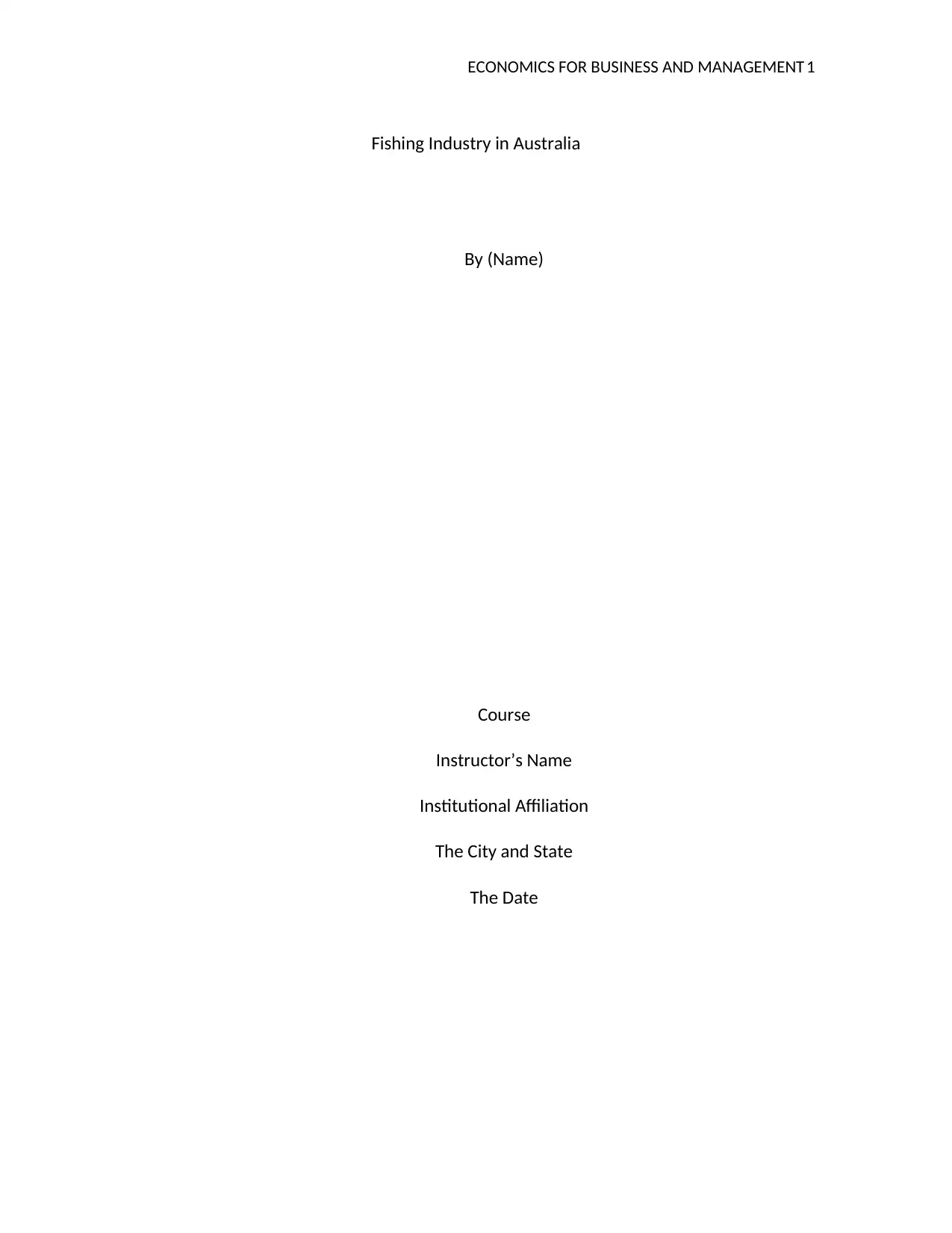
ECONOMICS FOR BUSINESS AND MANAGEMENT 1
Fishing Industry in Australia
By (Name)
Course
Instructor’s Name
Institutional Affiliation
The City and State
The Date
Fishing Industry in Australia
By (Name)
Course
Instructor’s Name
Institutional Affiliation
The City and State
The Date
Secure Best Marks with AI Grader
Need help grading? Try our AI Grader for instant feedback on your assignments.
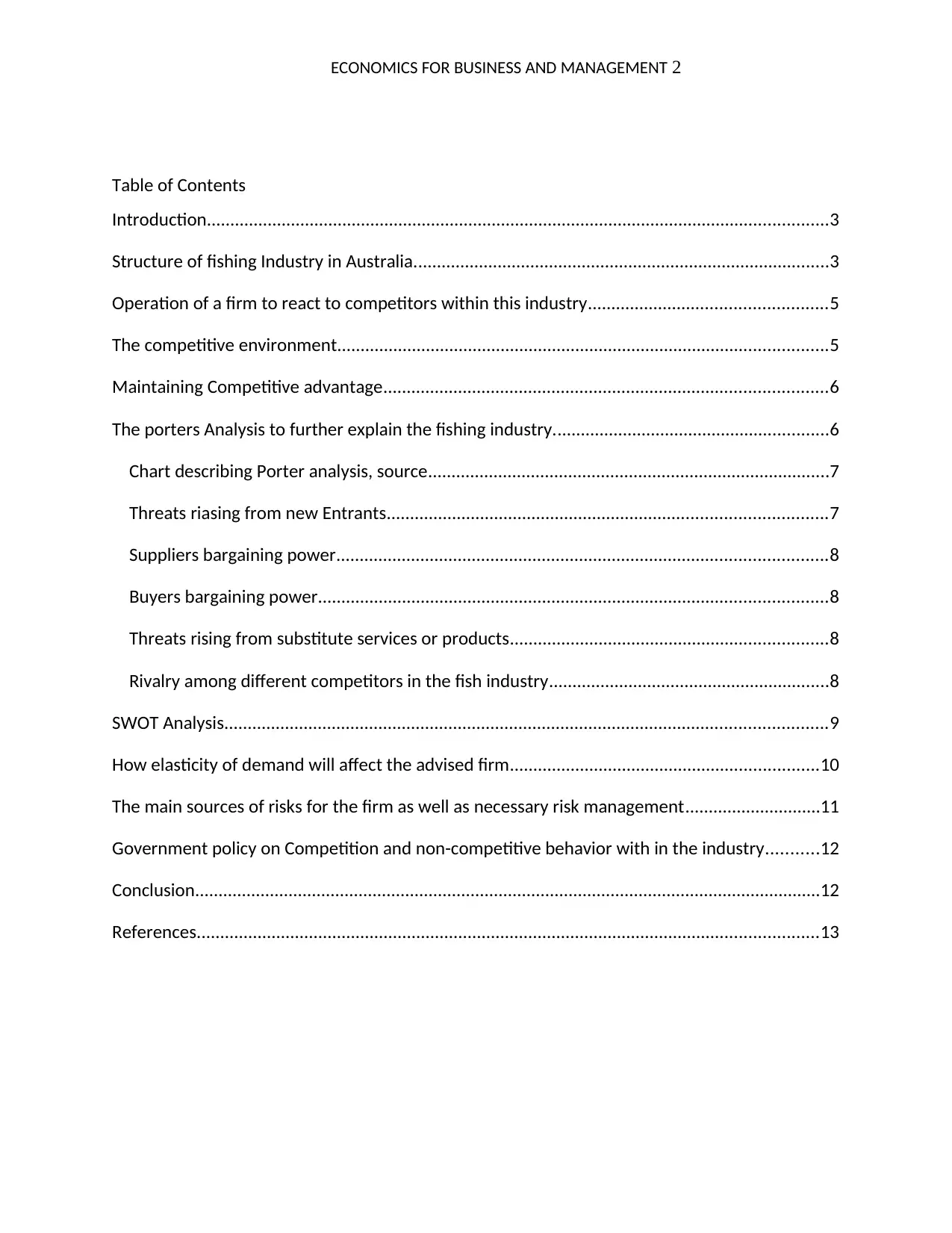
ECONOMICS FOR BUSINESS AND MANAGEMENT 2
Table of Contents
Introduction.....................................................................................................................................3
Structure of fishing Industry in Australia.........................................................................................3
Operation of a firm to react to competitors within this industry...................................................5
The competitive environment.........................................................................................................5
Maintaining Competitive advantage...............................................................................................6
The porters Analysis to further explain the fishing industry...........................................................6
Chart describing Porter analysis, source......................................................................................7
Threats riasing from new Entrants..............................................................................................7
Suppliers bargaining power.........................................................................................................8
Buyers bargaining power.............................................................................................................8
Threats rising from substitute services or products....................................................................8
Rivalry among different competitors in the fish industry............................................................8
SWOT Analysis.................................................................................................................................9
How elasticity of demand will affect the advised firm..................................................................10
The main sources of risks for the firm as well as necessary risk management.............................11
Government policy on Competition and non-competitive behavior with in the industry...........12
Conclusion......................................................................................................................................12
References.....................................................................................................................................13
Table of Contents
Introduction.....................................................................................................................................3
Structure of fishing Industry in Australia.........................................................................................3
Operation of a firm to react to competitors within this industry...................................................5
The competitive environment.........................................................................................................5
Maintaining Competitive advantage...............................................................................................6
The porters Analysis to further explain the fishing industry...........................................................6
Chart describing Porter analysis, source......................................................................................7
Threats riasing from new Entrants..............................................................................................7
Suppliers bargaining power.........................................................................................................8
Buyers bargaining power.............................................................................................................8
Threats rising from substitute services or products....................................................................8
Rivalry among different competitors in the fish industry............................................................8
SWOT Analysis.................................................................................................................................9
How elasticity of demand will affect the advised firm..................................................................10
The main sources of risks for the firm as well as necessary risk management.............................11
Government policy on Competition and non-competitive behavior with in the industry...........12
Conclusion......................................................................................................................................12
References.....................................................................................................................................13
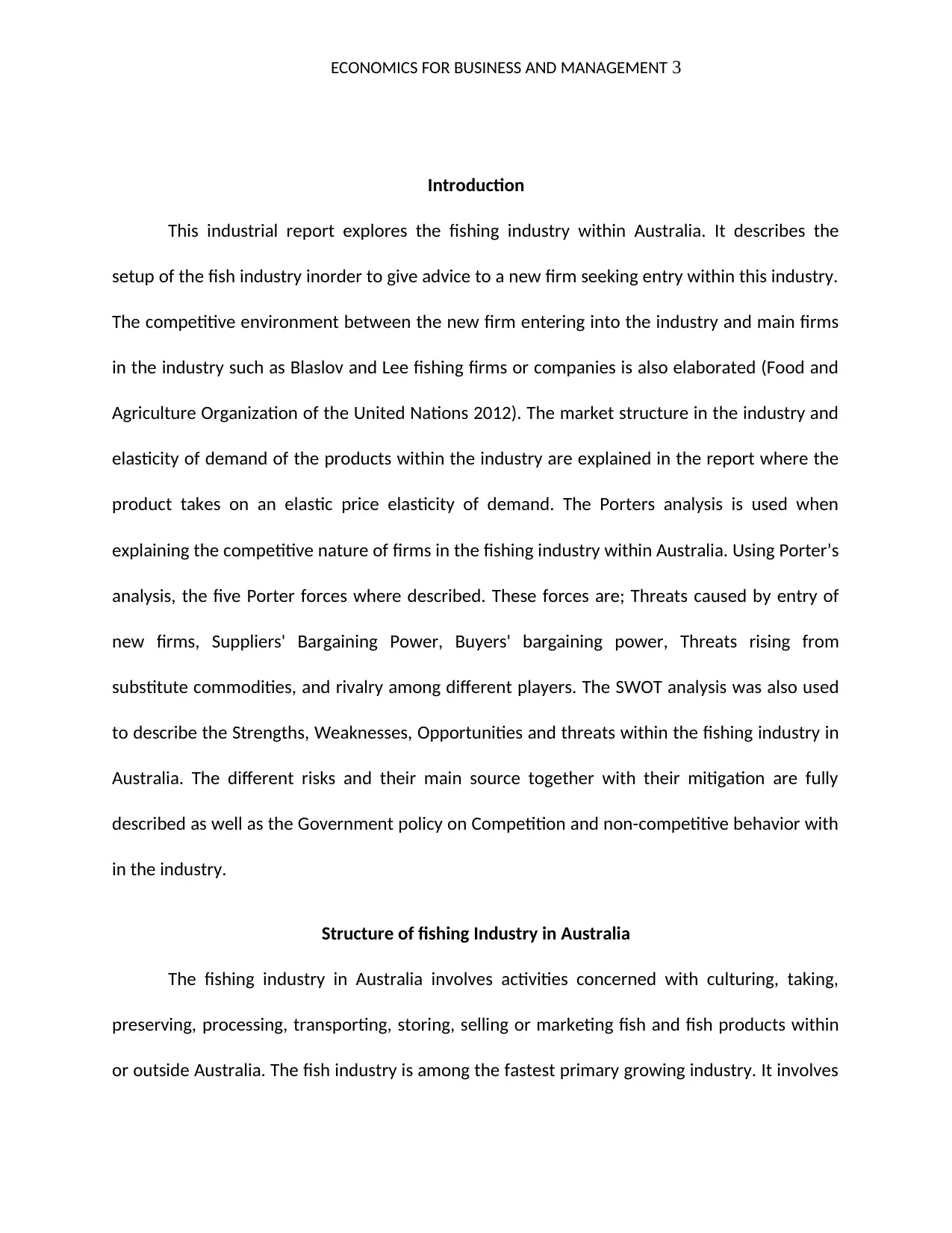
ECONOMICS FOR BUSINESS AND MANAGEMENT 3
Introduction
This industrial report explores the fishing industry within Australia. It describes the
setup of the fish industry inorder to give advice to a new firm seeking entry within this industry.
The competitive environment between the new firm entering into the industry and main firms
in the industry such as Blaslov and Lee fishing firms or companies is also elaborated (Food and
Agriculture Organization of the United Nations 2012). The market structure in the industry and
elasticity of demand of the products within the industry are explained in the report where the
product takes on an elastic price elasticity of demand. The Porters analysis is used when
explaining the competitive nature of firms in the fishing industry within Australia. Using Porter’s
analysis, the five Porter forces where described. These forces are; Threats caused by entry of
new firms, Suppliers' Bargaining Power, Buyers' bargaining power, Threats rising from
substitute commodities, and rivalry among different players. The SWOT analysis was also used
to describe the Strengths, Weaknesses, Opportunities and threats within the fishing industry in
Australia. The different risks and their main source together with their mitigation are fully
described as well as the Government policy on Competition and non-competitive behavior with
in the industry.
Structure of fishing Industry in Australia
The fishing industry in Australia involves activities concerned with culturing, taking,
preserving, processing, transporting, storing, selling or marketing fish and fish products within
or outside Australia. The fish industry is among the fastest primary growing industry. It involves
Introduction
This industrial report explores the fishing industry within Australia. It describes the
setup of the fish industry inorder to give advice to a new firm seeking entry within this industry.
The competitive environment between the new firm entering into the industry and main firms
in the industry such as Blaslov and Lee fishing firms or companies is also elaborated (Food and
Agriculture Organization of the United Nations 2012). The market structure in the industry and
elasticity of demand of the products within the industry are explained in the report where the
product takes on an elastic price elasticity of demand. The Porters analysis is used when
explaining the competitive nature of firms in the fishing industry within Australia. Using Porter’s
analysis, the five Porter forces where described. These forces are; Threats caused by entry of
new firms, Suppliers' Bargaining Power, Buyers' bargaining power, Threats rising from
substitute commodities, and rivalry among different players. The SWOT analysis was also used
to describe the Strengths, Weaknesses, Opportunities and threats within the fishing industry in
Australia. The different risks and their main source together with their mitigation are fully
described as well as the Government policy on Competition and non-competitive behavior with
in the industry.
Structure of fishing Industry in Australia
The fishing industry in Australia involves activities concerned with culturing, taking,
preserving, processing, transporting, storing, selling or marketing fish and fish products within
or outside Australia. The fish industry is among the fastest primary growing industry. It involves
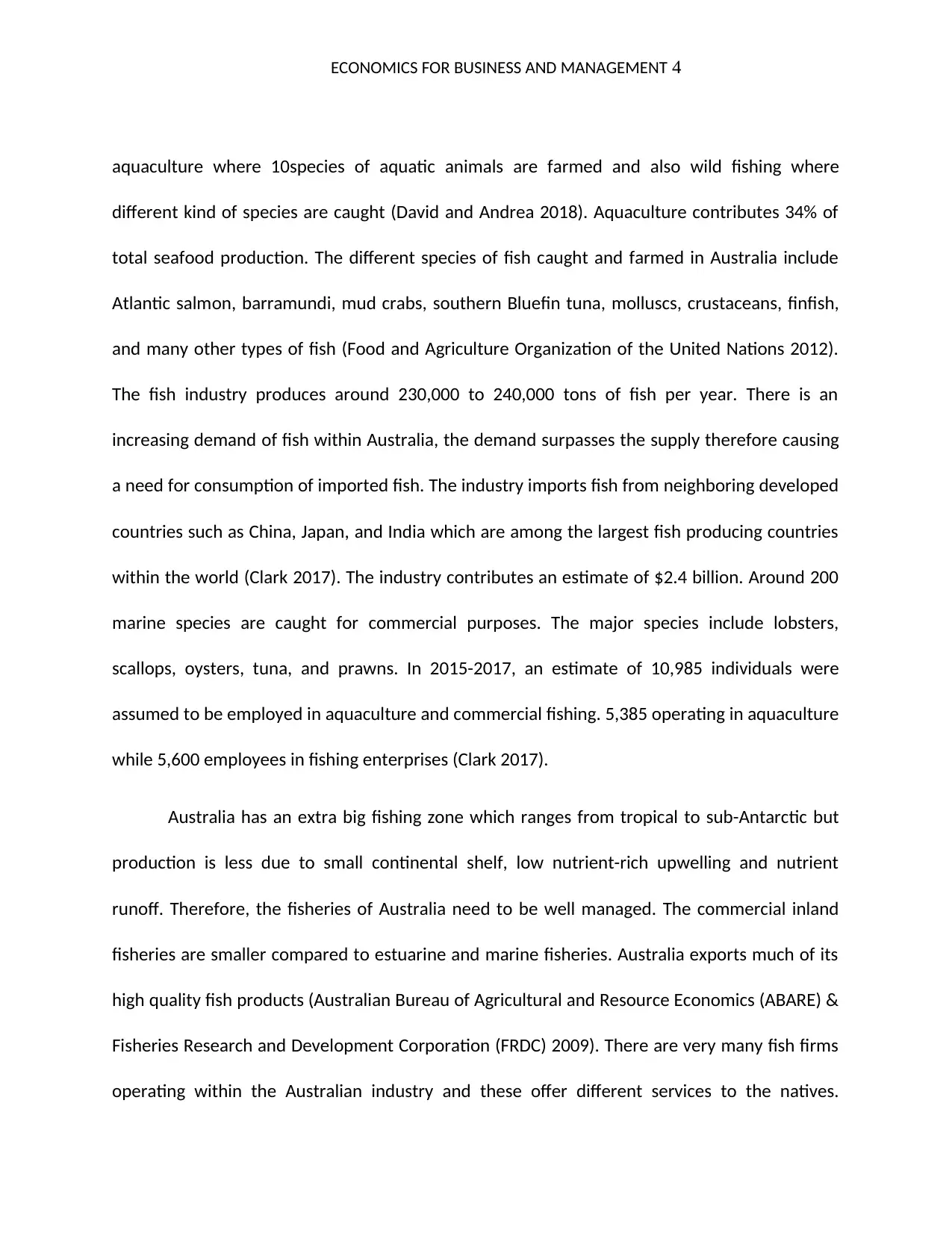
ECONOMICS FOR BUSINESS AND MANAGEMENT 4
aquaculture where 10species of aquatic animals are farmed and also wild fishing where
different kind of species are caught (David and Andrea 2018). Aquaculture contributes 34% of
total seafood production. The different species of fish caught and farmed in Australia include
Atlantic salmon, barramundi, mud crabs, southern Bluefin tuna, molluscs, crustaceans, finfish,
and many other types of fish (Food and Agriculture Organization of the United Nations 2012).
The fish industry produces around 230,000 to 240,000 tons of fish per year. There is an
increasing demand of fish within Australia, the demand surpasses the supply therefore causing
a need for consumption of imported fish. The industry imports fish from neighboring developed
countries such as China, Japan, and India which are among the largest fish producing countries
within the world (Clark 2017). The industry contributes an estimate of $2.4 billion. Around 200
marine species are caught for commercial purposes. The major species include lobsters,
scallops, oysters, tuna, and prawns. In 2015-2017, an estimate of 10,985 individuals were
assumed to be employed in aquaculture and commercial fishing. 5,385 operating in aquaculture
while 5,600 employees in fishing enterprises (Clark 2017).
Australia has an extra big fishing zone which ranges from tropical to sub-Antarctic but
production is less due to small continental shelf, low nutrient-rich upwelling and nutrient
runoff. Therefore, the fisheries of Australia need to be well managed. The commercial inland
fisheries are smaller compared to estuarine and marine fisheries. Australia exports much of its
high quality fish products (Australian Bureau of Agricultural and Resource Economics (ABARE) &
Fisheries Research and Development Corporation (FRDC) 2009). There are very many fish firms
operating within the Australian industry and these offer different services to the natives.
aquaculture where 10species of aquatic animals are farmed and also wild fishing where
different kind of species are caught (David and Andrea 2018). Aquaculture contributes 34% of
total seafood production. The different species of fish caught and farmed in Australia include
Atlantic salmon, barramundi, mud crabs, southern Bluefin tuna, molluscs, crustaceans, finfish,
and many other types of fish (Food and Agriculture Organization of the United Nations 2012).
The fish industry produces around 230,000 to 240,000 tons of fish per year. There is an
increasing demand of fish within Australia, the demand surpasses the supply therefore causing
a need for consumption of imported fish. The industry imports fish from neighboring developed
countries such as China, Japan, and India which are among the largest fish producing countries
within the world (Clark 2017). The industry contributes an estimate of $2.4 billion. Around 200
marine species are caught for commercial purposes. The major species include lobsters,
scallops, oysters, tuna, and prawns. In 2015-2017, an estimate of 10,985 individuals were
assumed to be employed in aquaculture and commercial fishing. 5,385 operating in aquaculture
while 5,600 employees in fishing enterprises (Clark 2017).
Australia has an extra big fishing zone which ranges from tropical to sub-Antarctic but
production is less due to small continental shelf, low nutrient-rich upwelling and nutrient
runoff. Therefore, the fisheries of Australia need to be well managed. The commercial inland
fisheries are smaller compared to estuarine and marine fisheries. Australia exports much of its
high quality fish products (Australian Bureau of Agricultural and Resource Economics (ABARE) &
Fisheries Research and Development Corporation (FRDC) 2009). There are very many fish firms
operating within the Australian industry and these offer different services to the natives.
Secure Best Marks with AI Grader
Need help grading? Try our AI Grader for instant feedback on your assignments.
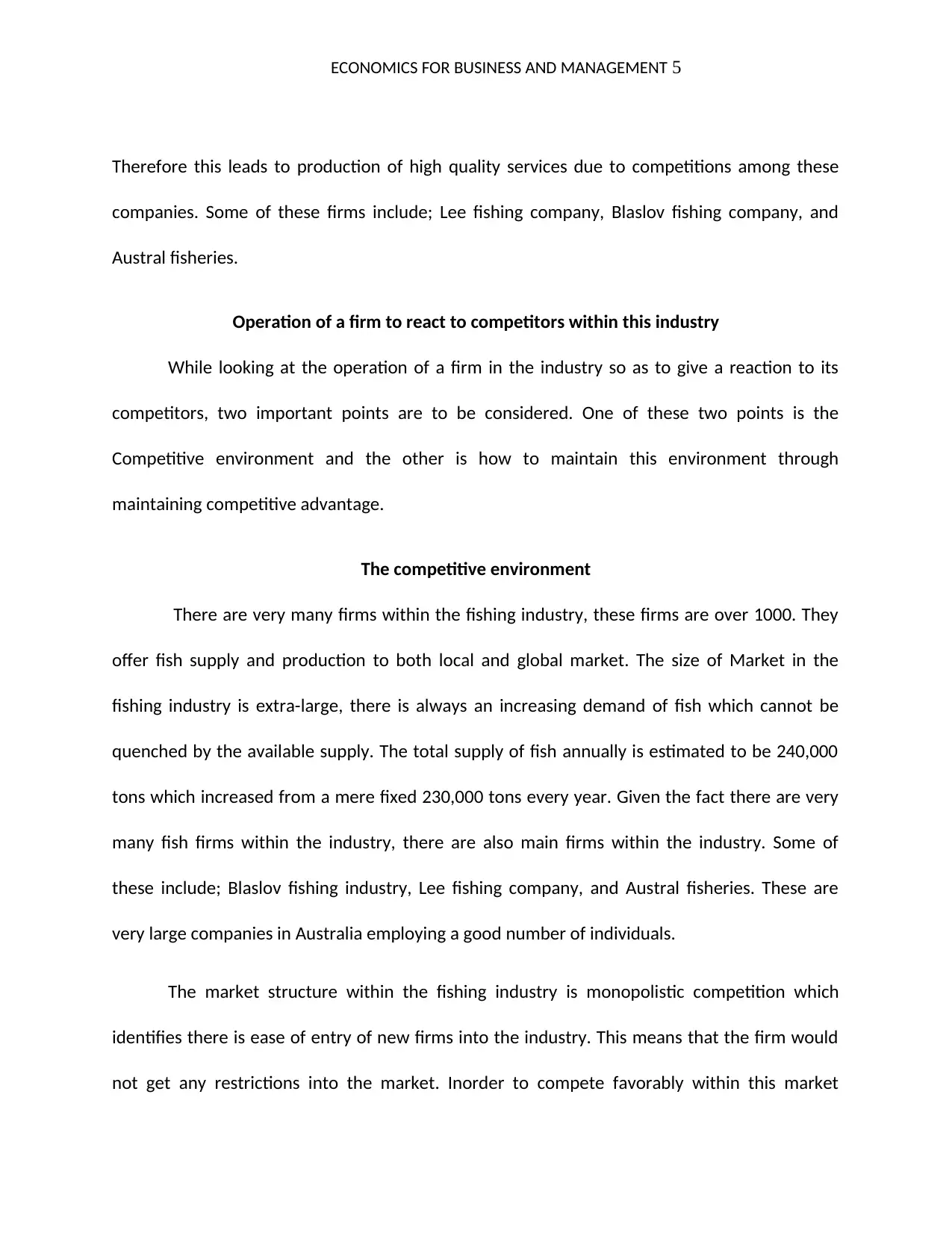
ECONOMICS FOR BUSINESS AND MANAGEMENT 5
Therefore this leads to production of high quality services due to competitions among these
companies. Some of these firms include; Lee fishing company, Blaslov fishing company, and
Austral fisheries.
Operation of a firm to react to competitors within this industry
While looking at the operation of a firm in the industry so as to give a reaction to its
competitors, two important points are to be considered. One of these two points is the
Competitive environment and the other is how to maintain this environment through
maintaining competitive advantage.
The competitive environment
There are very many firms within the fishing industry, these firms are over 1000. They
offer fish supply and production to both local and global market. The size of Market in the
fishing industry is extra-large, there is always an increasing demand of fish which cannot be
quenched by the available supply. The total supply of fish annually is estimated to be 240,000
tons which increased from a mere fixed 230,000 tons every year. Given the fact there are very
many fish firms within the industry, there are also main firms within the industry. Some of
these include; Blaslov fishing industry, Lee fishing company, and Austral fisheries. These are
very large companies in Australia employing a good number of individuals.
The market structure within the fishing industry is monopolistic competition which
identifies there is ease of entry of new firms into the industry. This means that the firm would
not get any restrictions into the market. Inorder to compete favorably within this market
Therefore this leads to production of high quality services due to competitions among these
companies. Some of these firms include; Lee fishing company, Blaslov fishing company, and
Austral fisheries.
Operation of a firm to react to competitors within this industry
While looking at the operation of a firm in the industry so as to give a reaction to its
competitors, two important points are to be considered. One of these two points is the
Competitive environment and the other is how to maintain this environment through
maintaining competitive advantage.
The competitive environment
There are very many firms within the fishing industry, these firms are over 1000. They
offer fish supply and production to both local and global market. The size of Market in the
fishing industry is extra-large, there is always an increasing demand of fish which cannot be
quenched by the available supply. The total supply of fish annually is estimated to be 240,000
tons which increased from a mere fixed 230,000 tons every year. Given the fact there are very
many fish firms within the industry, there are also main firms within the industry. Some of
these include; Blaslov fishing industry, Lee fishing company, and Austral fisheries. These are
very large companies in Australia employing a good number of individuals.
The market structure within the fishing industry is monopolistic competition which
identifies there is ease of entry of new firms into the industry. This means that the firm would
not get any restrictions into the market. Inorder to compete favorably within this market
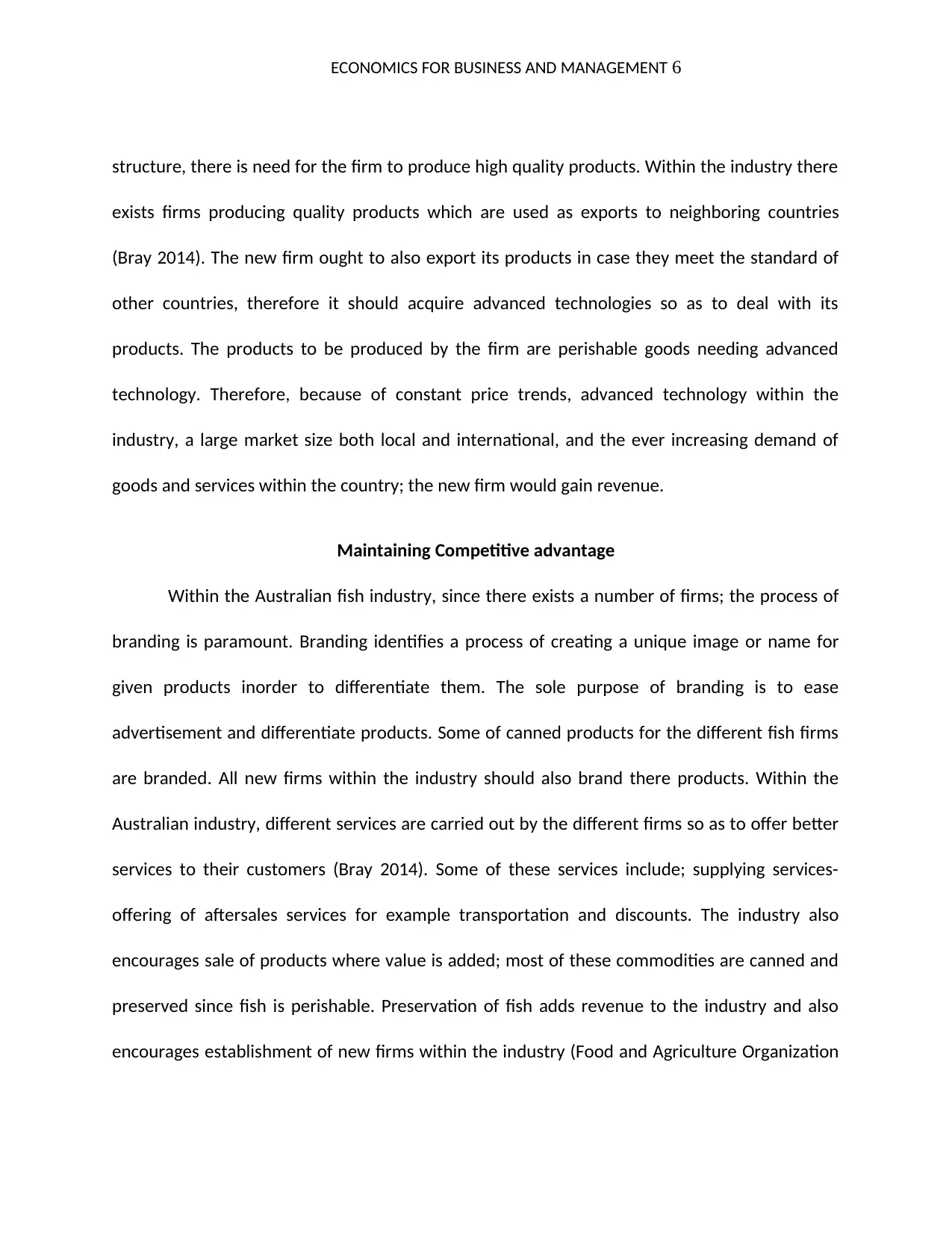
ECONOMICS FOR BUSINESS AND MANAGEMENT 6
structure, there is need for the firm to produce high quality products. Within the industry there
exists firms producing quality products which are used as exports to neighboring countries
(Bray 2014). The new firm ought to also export its products in case they meet the standard of
other countries, therefore it should acquire advanced technologies so as to deal with its
products. The products to be produced by the firm are perishable goods needing advanced
technology. Therefore, because of constant price trends, advanced technology within the
industry, a large market size both local and international, and the ever increasing demand of
goods and services within the country; the new firm would gain revenue.
Maintaining Competitive advantage
Within the Australian fish industry, since there exists a number of firms; the process of
branding is paramount. Branding identifies a process of creating a unique image or name for
given products inorder to differentiate them. The sole purpose of branding is to ease
advertisement and differentiate products. Some of canned products for the different fish firms
are branded. All new firms within the industry should also brand there products. Within the
Australian industry, different services are carried out by the different firms so as to offer better
services to their customers (Bray 2014). Some of these services include; supplying services-
offering of aftersales services for example transportation and discounts. The industry also
encourages sale of products where value is added; most of these commodities are canned and
preserved since fish is perishable. Preservation of fish adds revenue to the industry and also
encourages establishment of new firms within the industry (Food and Agriculture Organization
structure, there is need for the firm to produce high quality products. Within the industry there
exists firms producing quality products which are used as exports to neighboring countries
(Bray 2014). The new firm ought to also export its products in case they meet the standard of
other countries, therefore it should acquire advanced technologies so as to deal with its
products. The products to be produced by the firm are perishable goods needing advanced
technology. Therefore, because of constant price trends, advanced technology within the
industry, a large market size both local and international, and the ever increasing demand of
goods and services within the country; the new firm would gain revenue.
Maintaining Competitive advantage
Within the Australian fish industry, since there exists a number of firms; the process of
branding is paramount. Branding identifies a process of creating a unique image or name for
given products inorder to differentiate them. The sole purpose of branding is to ease
advertisement and differentiate products. Some of canned products for the different fish firms
are branded. All new firms within the industry should also brand there products. Within the
Australian industry, different services are carried out by the different firms so as to offer better
services to their customers (Bray 2014). Some of these services include; supplying services-
offering of aftersales services for example transportation and discounts. The industry also
encourages sale of products where value is added; most of these commodities are canned and
preserved since fish is perishable. Preservation of fish adds revenue to the industry and also
encourages establishment of new firms within the industry (Food and Agriculture Organization
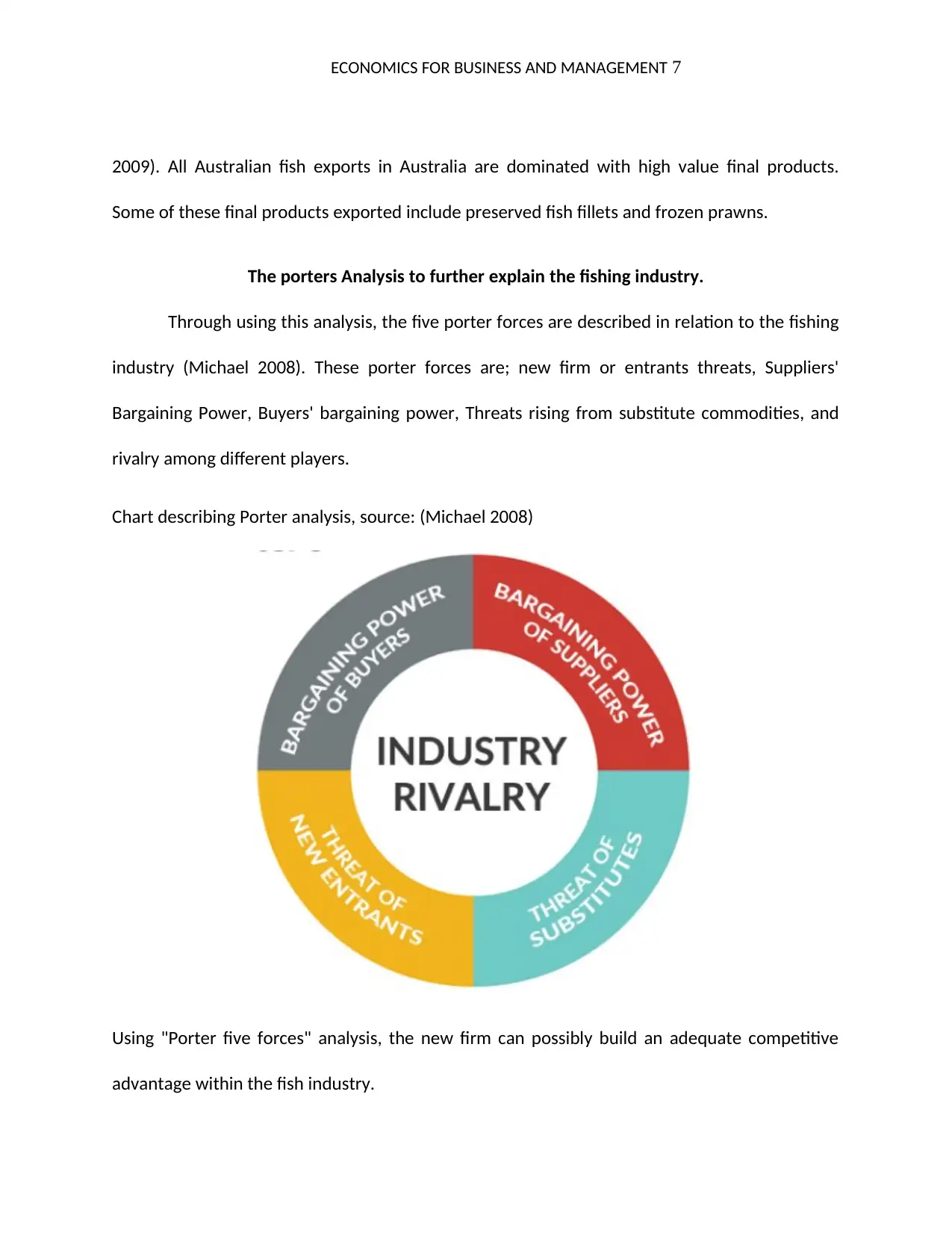
ECONOMICS FOR BUSINESS AND MANAGEMENT 7
2009). All Australian fish exports in Australia are dominated with high value final products.
Some of these final products exported include preserved fish fillets and frozen prawns.
The porters Analysis to further explain the fishing industry.
Through using this analysis, the five porter forces are described in relation to the fishing
industry (Michael 2008). These porter forces are; new firm or entrants threats, Suppliers'
Bargaining Power, Buyers' bargaining power, Threats rising from substitute commodities, and
rivalry among different players.
Chart describing Porter analysis, source: (Michael 2008)
Using "Porter five forces" analysis, the new firm can possibly build an adequate competitive
advantage within the fish industry.
2009). All Australian fish exports in Australia are dominated with high value final products.
Some of these final products exported include preserved fish fillets and frozen prawns.
The porters Analysis to further explain the fishing industry.
Through using this analysis, the five porter forces are described in relation to the fishing
industry (Michael 2008). These porter forces are; new firm or entrants threats, Suppliers'
Bargaining Power, Buyers' bargaining power, Threats rising from substitute commodities, and
rivalry among different players.
Chart describing Porter analysis, source: (Michael 2008)
Using "Porter five forces" analysis, the new firm can possibly build an adequate competitive
advantage within the fish industry.
Paraphrase This Document
Need a fresh take? Get an instant paraphrase of this document with our AI Paraphraser
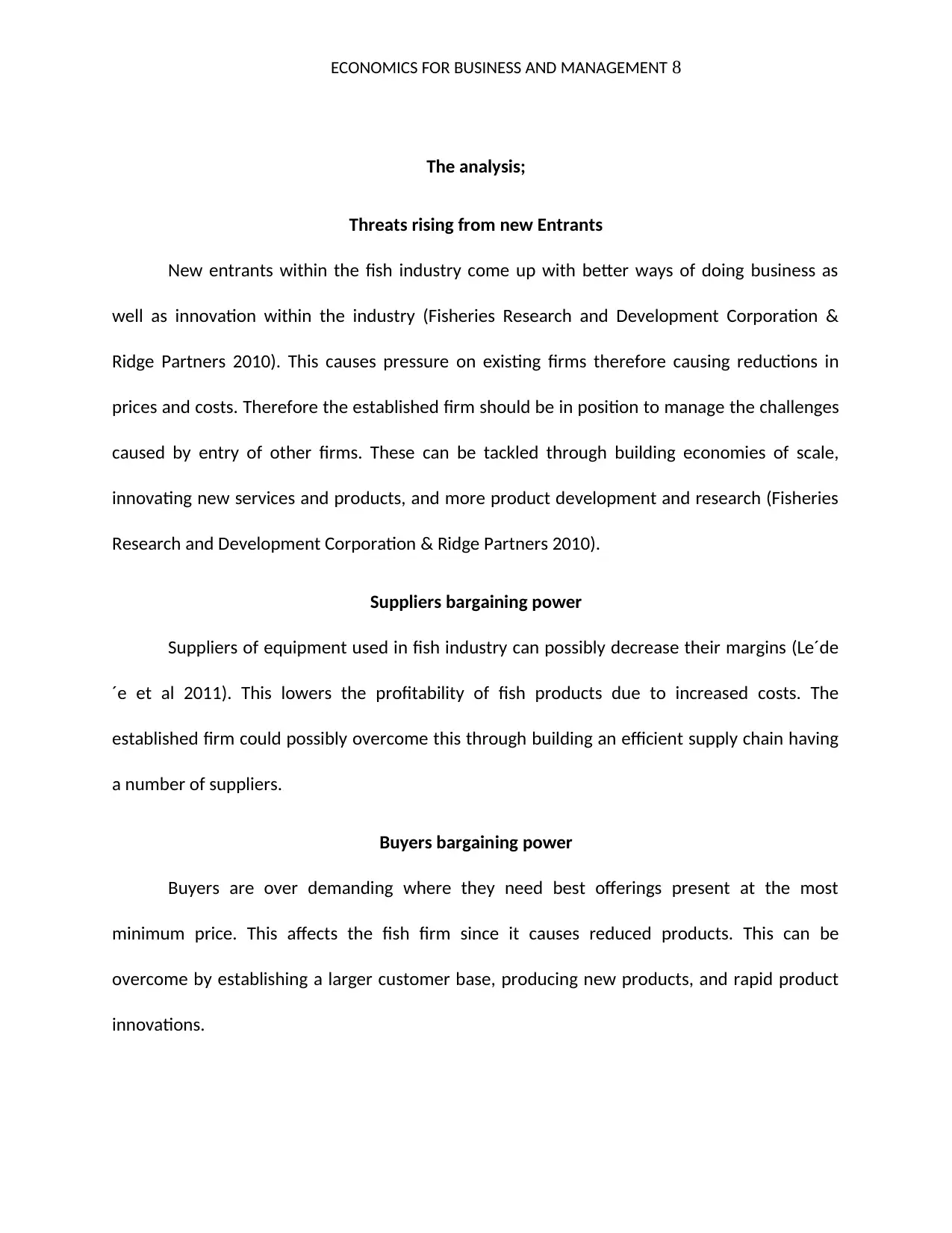
ECONOMICS FOR BUSINESS AND MANAGEMENT 8
The analysis;
Threats rising from new Entrants
New entrants within the fish industry come up with better ways of doing business as
well as innovation within the industry (Fisheries Research and Development Corporation &
Ridge Partners 2010). This causes pressure on existing firms therefore causing reductions in
prices and costs. Therefore the established firm should be in position to manage the challenges
caused by entry of other firms. These can be tackled through building economies of scale,
innovating new services and products, and more product development and research (Fisheries
Research and Development Corporation & Ridge Partners 2010).
Suppliers bargaining power
Suppliers of equipment used in fish industry can possibly decrease their margins (Le´de
´e et al 2011). This lowers the profitability of fish products due to increased costs. The
established firm could possibly overcome this through building an efficient supply chain having
a number of suppliers.
Buyers bargaining power
Buyers are over demanding where they need best offerings present at the most
minimum price. This affects the fish firm since it causes reduced products. This can be
overcome by establishing a larger customer base, producing new products, and rapid product
innovations.
The analysis;
Threats rising from new Entrants
New entrants within the fish industry come up with better ways of doing business as
well as innovation within the industry (Fisheries Research and Development Corporation &
Ridge Partners 2010). This causes pressure on existing firms therefore causing reductions in
prices and costs. Therefore the established firm should be in position to manage the challenges
caused by entry of other firms. These can be tackled through building economies of scale,
innovating new services and products, and more product development and research (Fisheries
Research and Development Corporation & Ridge Partners 2010).
Suppliers bargaining power
Suppliers of equipment used in fish industry can possibly decrease their margins (Le´de
´e et al 2011). This lowers the profitability of fish products due to increased costs. The
established firm could possibly overcome this through building an efficient supply chain having
a number of suppliers.
Buyers bargaining power
Buyers are over demanding where they need best offerings present at the most
minimum price. This affects the fish firm since it causes reduced products. This can be
overcome by establishing a larger customer base, producing new products, and rapid product
innovations.
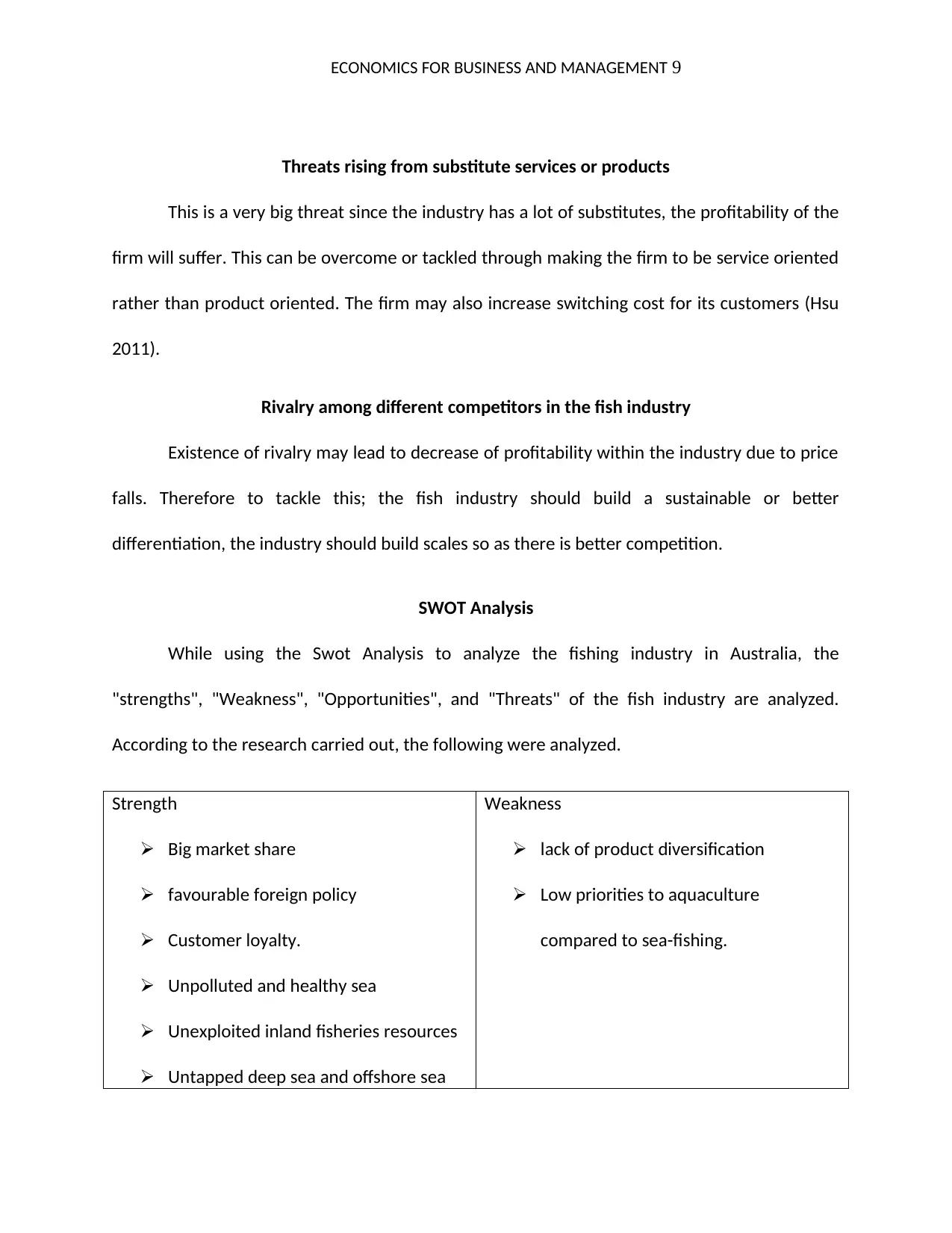
ECONOMICS FOR BUSINESS AND MANAGEMENT 9
Threats rising from substitute services or products
This is a very big threat since the industry has a lot of substitutes, the profitability of the
firm will suffer. This can be overcome or tackled through making the firm to be service oriented
rather than product oriented. The firm may also increase switching cost for its customers (Hsu
2011).
Rivalry among different competitors in the fish industry
Existence of rivalry may lead to decrease of profitability within the industry due to price
falls. Therefore to tackle this; the fish industry should build a sustainable or better
differentiation, the industry should build scales so as there is better competition.
SWOT Analysis
While using the Swot Analysis to analyze the fishing industry in Australia, the
"strengths", "Weakness", "Opportunities", and "Threats" of the fish industry are analyzed.
According to the research carried out, the following were analyzed.
Strength
Big market share
favourable foreign policy
Customer loyalty.
Unpolluted and healthy sea
Unexploited inland fisheries resources
Untapped deep sea and offshore sea
Weakness
lack of product diversification
Low priorities to aquaculture
compared to sea-fishing.
Threats rising from substitute services or products
This is a very big threat since the industry has a lot of substitutes, the profitability of the
firm will suffer. This can be overcome or tackled through making the firm to be service oriented
rather than product oriented. The firm may also increase switching cost for its customers (Hsu
2011).
Rivalry among different competitors in the fish industry
Existence of rivalry may lead to decrease of profitability within the industry due to price
falls. Therefore to tackle this; the fish industry should build a sustainable or better
differentiation, the industry should build scales so as there is better competition.
SWOT Analysis
While using the Swot Analysis to analyze the fishing industry in Australia, the
"strengths", "Weakness", "Opportunities", and "Threats" of the fish industry are analyzed.
According to the research carried out, the following were analyzed.
Strength
Big market share
favourable foreign policy
Customer loyalty.
Unpolluted and healthy sea
Unexploited inland fisheries resources
Untapped deep sea and offshore sea
Weakness
lack of product diversification
Low priorities to aquaculture
compared to sea-fishing.
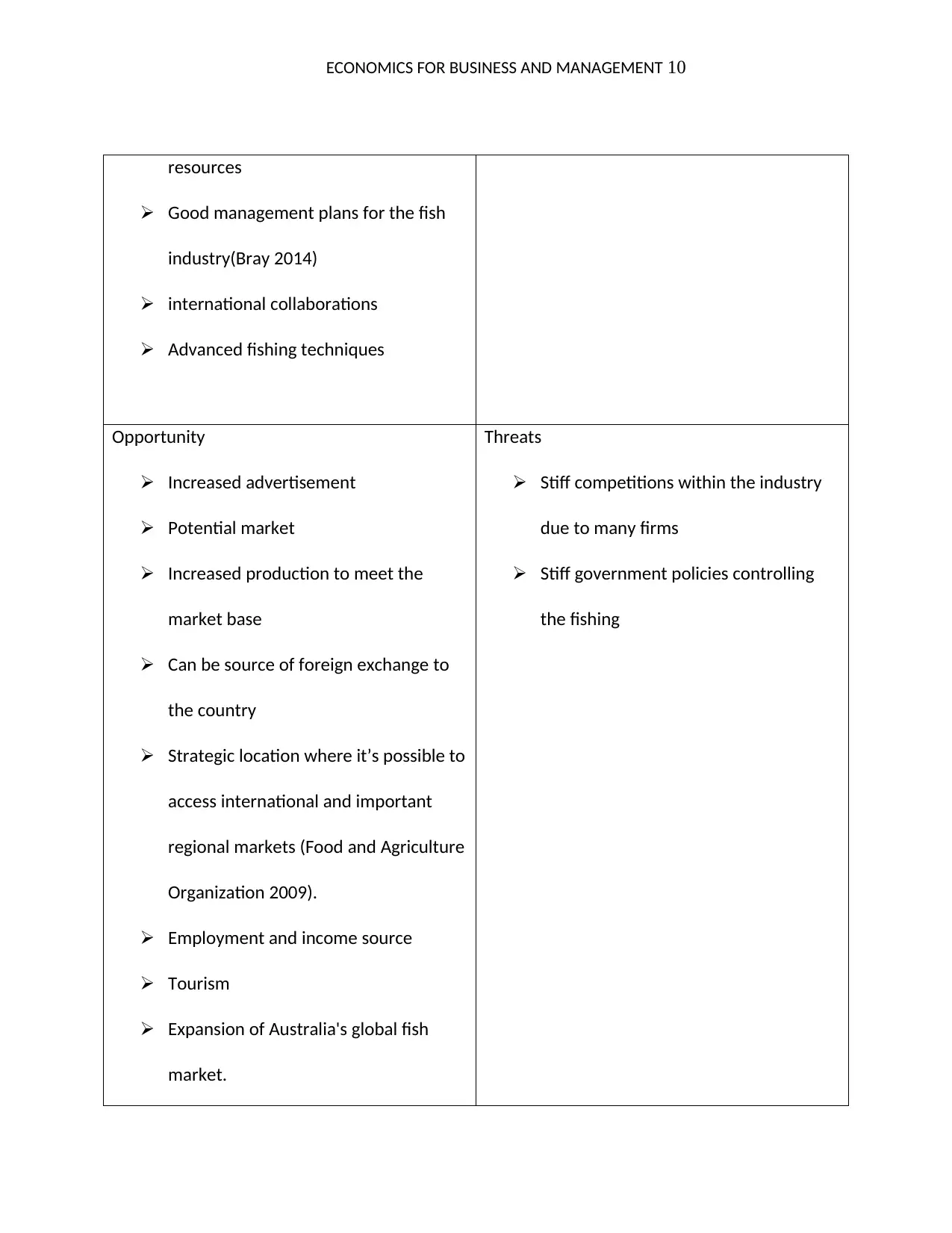
ECONOMICS FOR BUSINESS AND MANAGEMENT 10
resources
Good management plans for the fish
industry(Bray 2014)
international collaborations
Advanced fishing techniques
Opportunity
Increased advertisement
Potential market
Increased production to meet the
market base
Can be source of foreign exchange to
the country
Strategic location where it’s possible to
access international and important
regional markets (Food and Agriculture
Organization 2009).
Employment and income source
Tourism
Expansion of Australia's global fish
market.
Threats
Stiff competitions within the industry
due to many firms
Stiff government policies controlling
the fishing
resources
Good management plans for the fish
industry(Bray 2014)
international collaborations
Advanced fishing techniques
Opportunity
Increased advertisement
Potential market
Increased production to meet the
market base
Can be source of foreign exchange to
the country
Strategic location where it’s possible to
access international and important
regional markets (Food and Agriculture
Organization 2009).
Employment and income source
Tourism
Expansion of Australia's global fish
market.
Threats
Stiff competitions within the industry
due to many firms
Stiff government policies controlling
the fishing
Secure Best Marks with AI Grader
Need help grading? Try our AI Grader for instant feedback on your assignments.
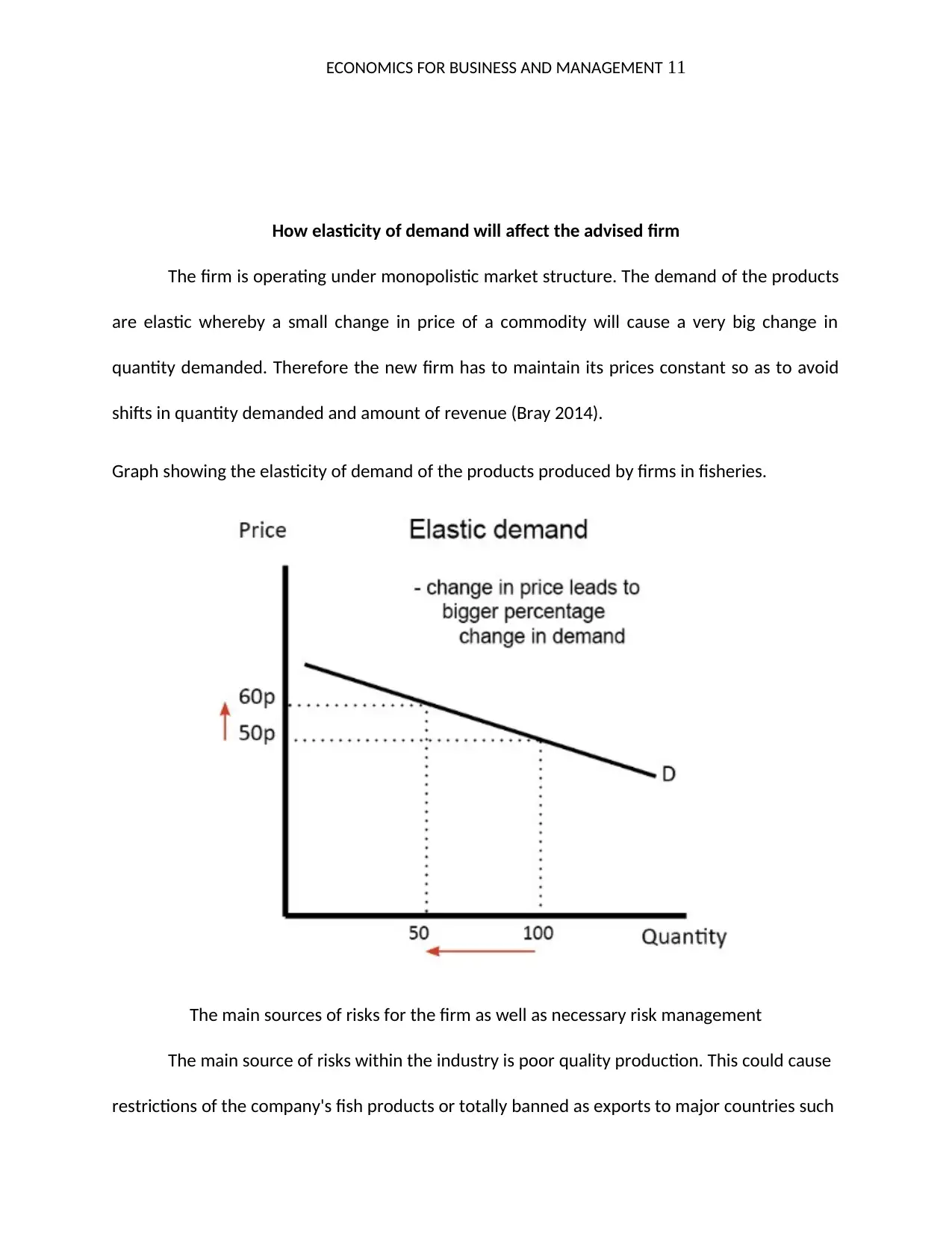
ECONOMICS FOR BUSINESS AND MANAGEMENT 11
How elasticity of demand will affect the advised firm
The firm is operating under monopolistic market structure. The demand of the products
are elastic whereby a small change in price of a commodity will cause a very big change in
quantity demanded. Therefore the new firm has to maintain its prices constant so as to avoid
shifts in quantity demanded and amount of revenue (Bray 2014).
Graph showing the elasticity of demand of the products produced by firms in fisheries.
The main sources of risks for the firm as well as necessary risk management
The main source of risks within the industry is poor quality production. This could cause
restrictions of the company's fish products or totally banned as exports to major countries such
How elasticity of demand will affect the advised firm
The firm is operating under monopolistic market structure. The demand of the products
are elastic whereby a small change in price of a commodity will cause a very big change in
quantity demanded. Therefore the new firm has to maintain its prices constant so as to avoid
shifts in quantity demanded and amount of revenue (Bray 2014).
Graph showing the elasticity of demand of the products produced by firms in fisheries.
The main sources of risks for the firm as well as necessary risk management
The main source of risks within the industry is poor quality production. This could cause
restrictions of the company's fish products or totally banned as exports to major countries such
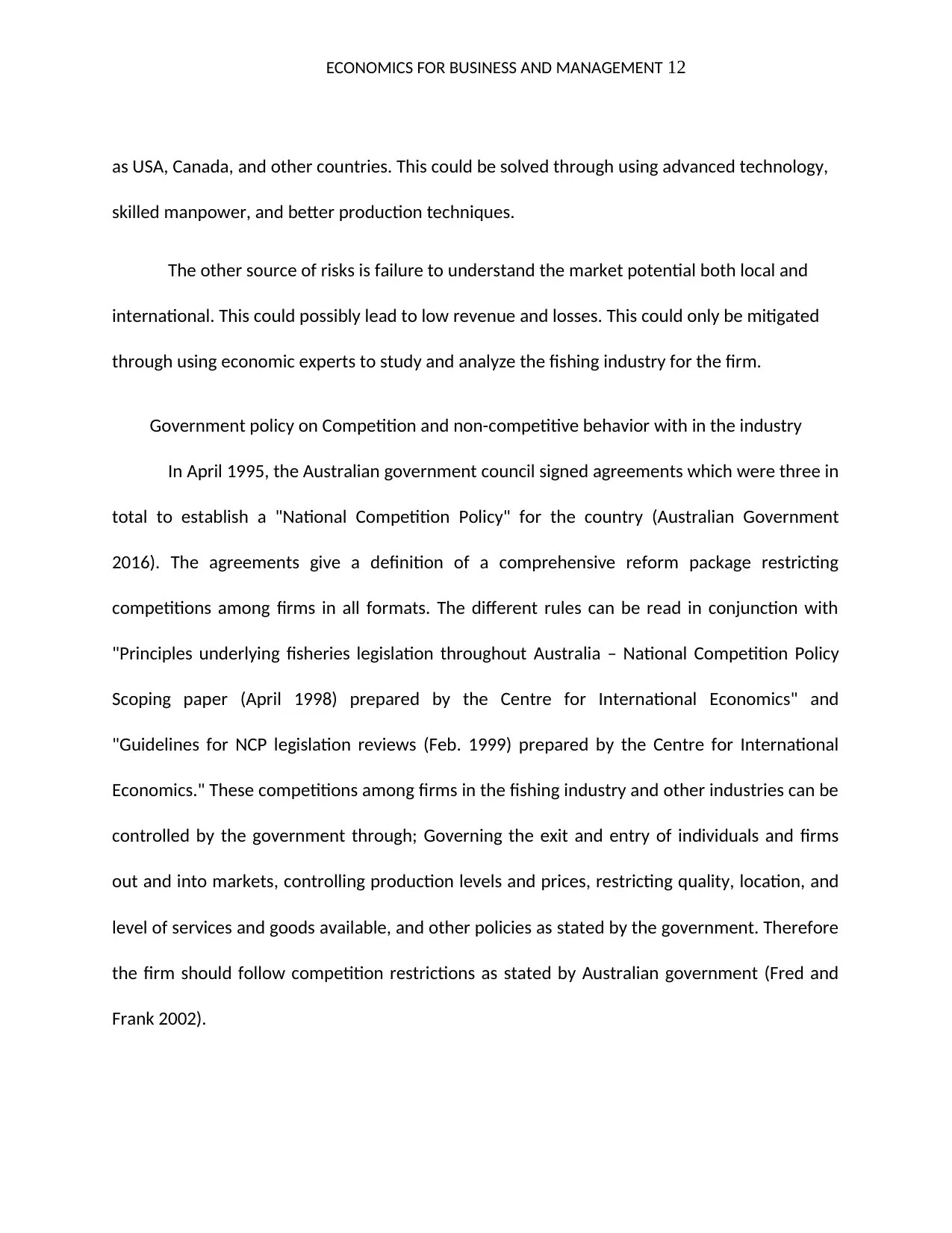
ECONOMICS FOR BUSINESS AND MANAGEMENT 12
as USA, Canada, and other countries. This could be solved through using advanced technology,
skilled manpower, and better production techniques.
The other source of risks is failure to understand the market potential both local and
international. This could possibly lead to low revenue and losses. This could only be mitigated
through using economic experts to study and analyze the fishing industry for the firm.
Government policy on Competition and non-competitive behavior with in the industry
In April 1995, the Australian government council signed agreements which were three in
total to establish a "National Competition Policy" for the country (Australian Government
2016). The agreements give a definition of a comprehensive reform package restricting
competitions among firms in all formats. The different rules can be read in conjunction with
"Principles underlying fisheries legislation throughout Australia – National Competition Policy
Scoping paper (April 1998) prepared by the Centre for International Economics" and
"Guidelines for NCP legislation reviews (Feb. 1999) prepared by the Centre for International
Economics." These competitions among firms in the fishing industry and other industries can be
controlled by the government through; Governing the exit and entry of individuals and firms
out and into markets, controlling production levels and prices, restricting quality, location, and
level of services and goods available, and other policies as stated by the government. Therefore
the firm should follow competition restrictions as stated by Australian government (Fred and
Frank 2002).
as USA, Canada, and other countries. This could be solved through using advanced technology,
skilled manpower, and better production techniques.
The other source of risks is failure to understand the market potential both local and
international. This could possibly lead to low revenue and losses. This could only be mitigated
through using economic experts to study and analyze the fishing industry for the firm.
Government policy on Competition and non-competitive behavior with in the industry
In April 1995, the Australian government council signed agreements which were three in
total to establish a "National Competition Policy" for the country (Australian Government
2016). The agreements give a definition of a comprehensive reform package restricting
competitions among firms in all formats. The different rules can be read in conjunction with
"Principles underlying fisheries legislation throughout Australia – National Competition Policy
Scoping paper (April 1998) prepared by the Centre for International Economics" and
"Guidelines for NCP legislation reviews (Feb. 1999) prepared by the Centre for International
Economics." These competitions among firms in the fishing industry and other industries can be
controlled by the government through; Governing the exit and entry of individuals and firms
out and into markets, controlling production levels and prices, restricting quality, location, and
level of services and goods available, and other policies as stated by the government. Therefore
the firm should follow competition restrictions as stated by Australian government (Fred and
Frank 2002).

ECONOMICS FOR BUSINESS AND MANAGEMENT 13
Conclusion
According to the report, the fishing industry is one of the sources of food and revenue
to the different people within Australia. It involves Aquaculture where 10 specie are farmed and
also sea-fishing where different kinds of species are caught. This industry operates under
monopolistic tendencies where 240,000 tons of fish are caught annually and sold both locally
and internationally. There is competition in the industry among different numerous companies
though this competition is governed by the government through the three agreements that
where signed by its council. Therefore, a firm entering the industry should fully understand the
different setup of this industry to avoid risks of losses.
Conclusion
According to the report, the fishing industry is one of the sources of food and revenue
to the different people within Australia. It involves Aquaculture where 10 specie are farmed and
also sea-fishing where different kinds of species are caught. This industry operates under
monopolistic tendencies where 240,000 tons of fish are caught annually and sold both locally
and internationally. There is competition in the industry among different numerous companies
though this competition is governed by the government through the three agreements that
where signed by its council. Therefore, a firm entering the industry should fully understand the
different setup of this industry to avoid risks of losses.
Paraphrase This Document
Need a fresh take? Get an instant paraphrase of this document with our AI Paraphraser
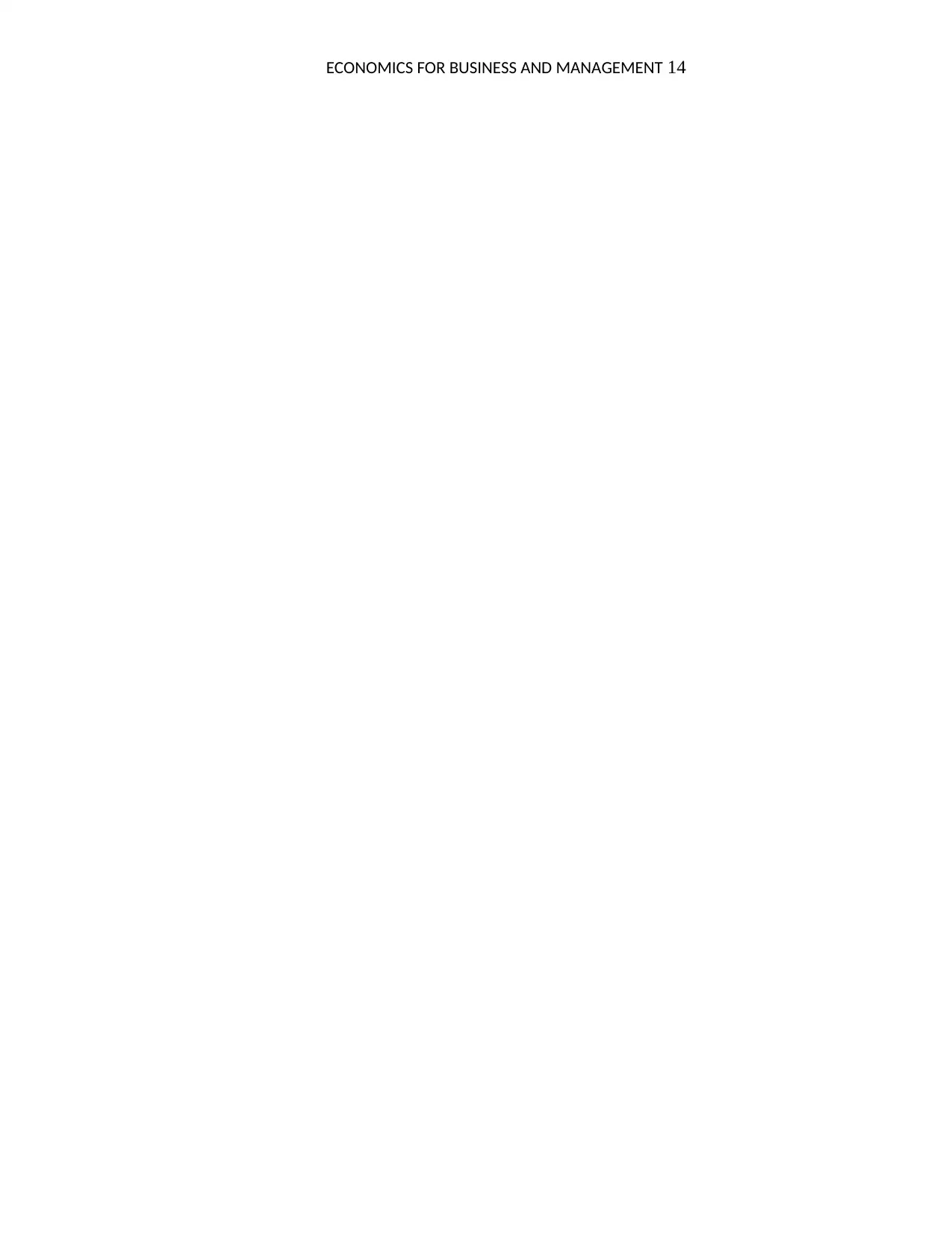
ECONOMICS FOR BUSINESS AND MANAGEMENT 14
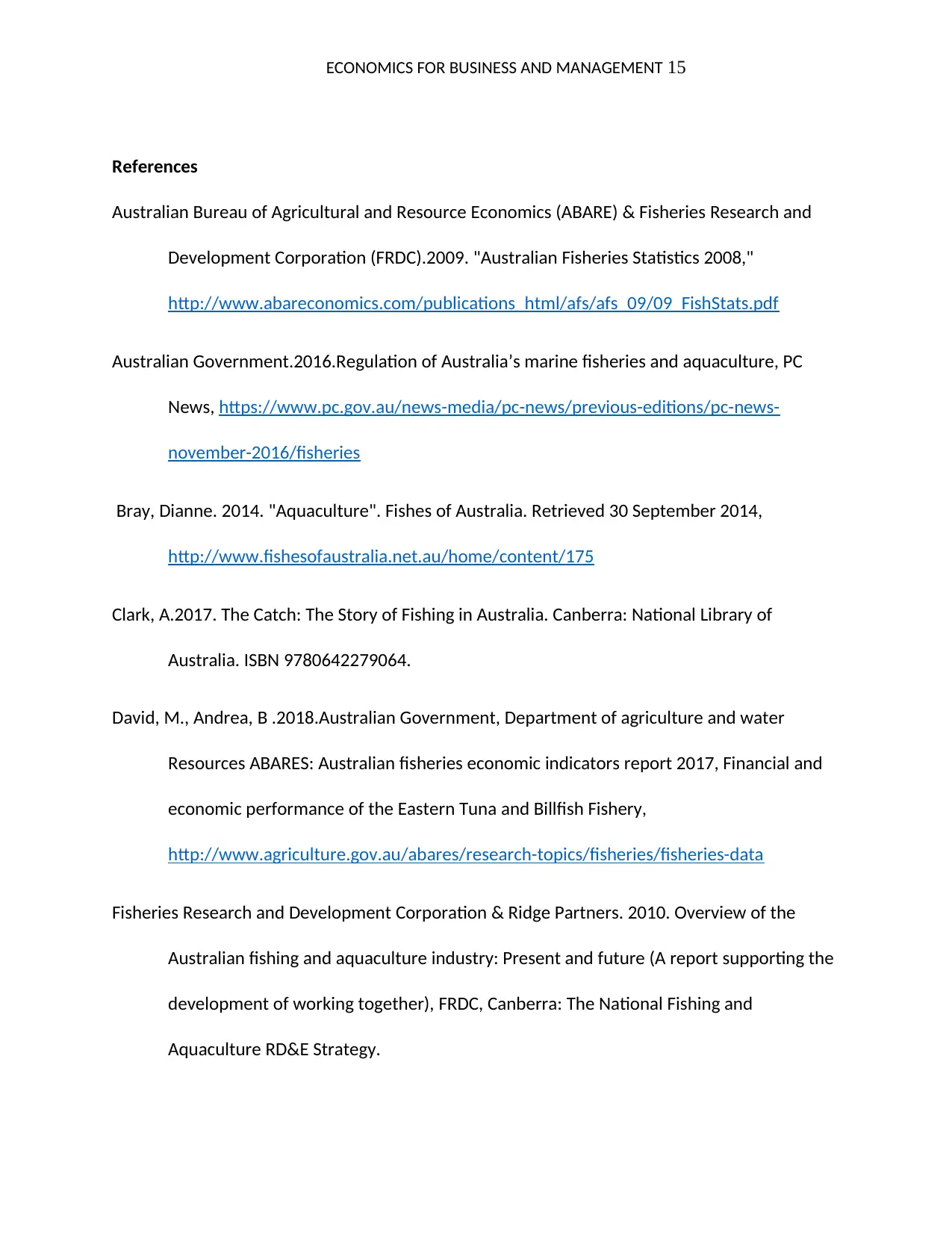
ECONOMICS FOR BUSINESS AND MANAGEMENT 15
References
Australian Bureau of Agricultural and Resource Economics (ABARE) & Fisheries Research and
Development Corporation (FRDC).2009. "Australian Fisheries Statistics 2008,"
http://www.abareconomics.com/publications_html/afs/afs_09/09_FishStats.pdf
Australian Government.2016.Regulation of Australia’s marine fisheries and aquaculture, PC
News, https://www.pc.gov.au/news-media/pc-news/previous-editions/pc-news-
november-2016/fisheries
Bray, Dianne. 2014. "Aquaculture". Fishes of Australia. Retrieved 30 September 2014,
http://www.fishesofaustralia.net.au/home/content/175
Clark, A.2017. The Catch: The Story of Fishing in Australia. Canberra: National Library of
Australia. ISBN 9780642279064.
David, M., Andrea, B .2018.Australian Government, Department of agriculture and water
Resources ABARES: Australian fisheries economic indicators report 2017, Financial and
economic performance of the Eastern Tuna and Billfish Fishery,
http://www.agriculture.gov.au/abares/research-topics/fisheries/fisheries-data
Fisheries Research and Development Corporation & Ridge Partners. 2010. Overview of the
Australian fishing and aquaculture industry: Present and future (A report supporting the
development of working together), FRDC, Canberra: The National Fishing and
Aquaculture RD&E Strategy.
References
Australian Bureau of Agricultural and Resource Economics (ABARE) & Fisheries Research and
Development Corporation (FRDC).2009. "Australian Fisheries Statistics 2008,"
http://www.abareconomics.com/publications_html/afs/afs_09/09_FishStats.pdf
Australian Government.2016.Regulation of Australia’s marine fisheries and aquaculture, PC
News, https://www.pc.gov.au/news-media/pc-news/previous-editions/pc-news-
november-2016/fisheries
Bray, Dianne. 2014. "Aquaculture". Fishes of Australia. Retrieved 30 September 2014,
http://www.fishesofaustralia.net.au/home/content/175
Clark, A.2017. The Catch: The Story of Fishing in Australia. Canberra: National Library of
Australia. ISBN 9780642279064.
David, M., Andrea, B .2018.Australian Government, Department of agriculture and water
Resources ABARES: Australian fisheries economic indicators report 2017, Financial and
economic performance of the Eastern Tuna and Billfish Fishery,
http://www.agriculture.gov.au/abares/research-topics/fisheries/fisheries-data
Fisheries Research and Development Corporation & Ridge Partners. 2010. Overview of the
Australian fishing and aquaculture industry: Present and future (A report supporting the
development of working together), FRDC, Canberra: The National Fishing and
Aquaculture RD&E Strategy.
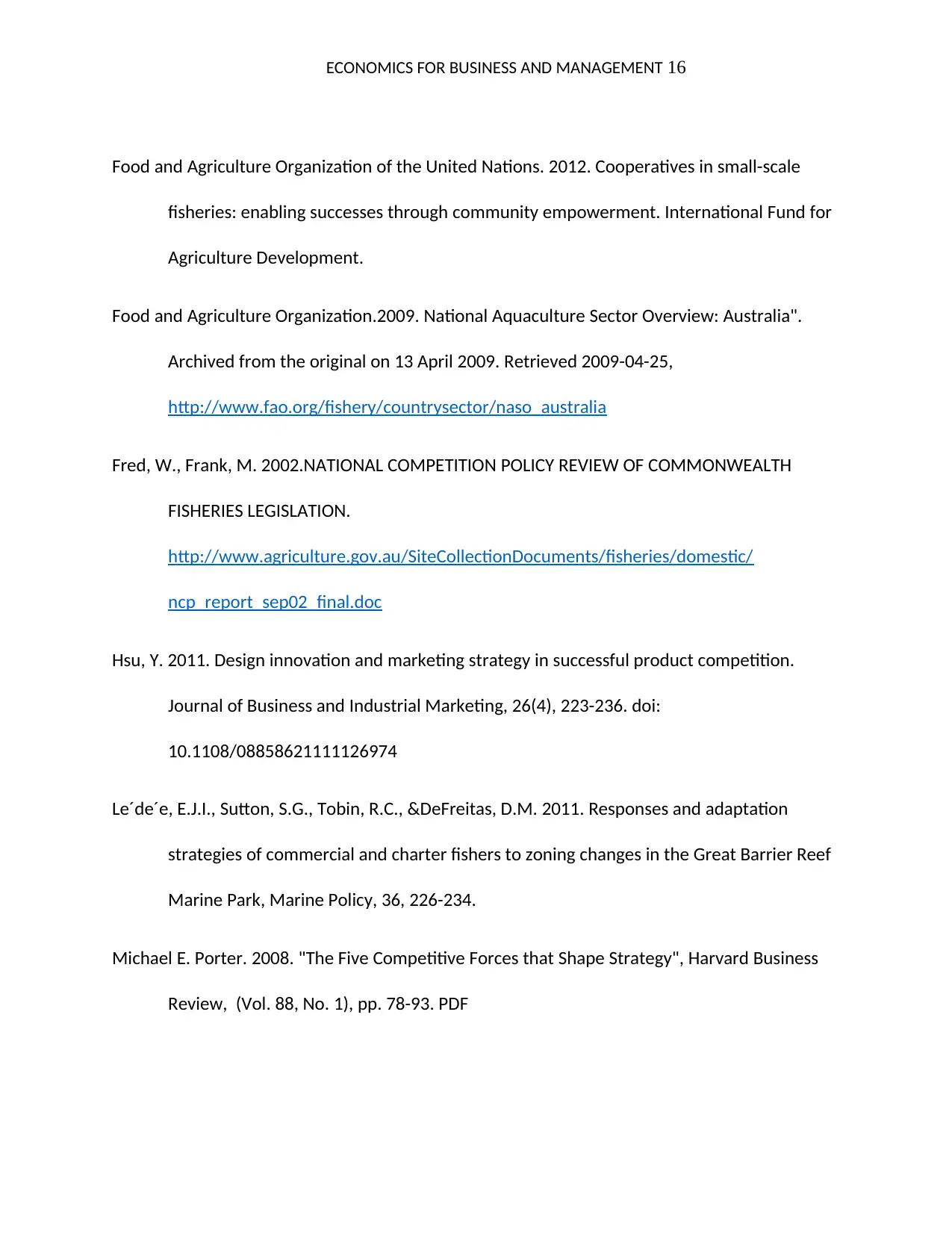
ECONOMICS FOR BUSINESS AND MANAGEMENT 16
Food and Agriculture Organization of the United Nations. 2012. Cooperatives in small-scale
fisheries: enabling successes through community empowerment. International Fund for
Agriculture Development.
Food and Agriculture Organization.2009. National Aquaculture Sector Overview: Australia".
Archived from the original on 13 April 2009. Retrieved 2009-04-25,
http://www.fao.org/fishery/countrysector/naso_australia
Fred, W., Frank, M. 2002.NATIONAL COMPETITION POLICY REVIEW OF COMMONWEALTH
FISHERIES LEGISLATION.
http://www.agriculture.gov.au/SiteCollectionDocuments/fisheries/domestic/
ncp_report_sep02_final.doc
Hsu, Y. 2011. Design innovation and marketing strategy in successful product competition.
Journal of Business and Industrial Marketing, 26(4), 223-236. doi:
10.1108/08858621111126974
Le´de´e, E.J.I., Sutton, S.G., Tobin, R.C., &DeFreitas, D.M. 2011. Responses and adaptation
strategies of commercial and charter fishers to zoning changes in the Great Barrier Reef
Marine Park, Marine Policy, 36, 226-234.
Michael E. Porter. 2008. "The Five Competitive Forces that Shape Strategy", Harvard Business
Review, (Vol. 88, No. 1), pp. 78-93. PDF
Food and Agriculture Organization of the United Nations. 2012. Cooperatives in small-scale
fisheries: enabling successes through community empowerment. International Fund for
Agriculture Development.
Food and Agriculture Organization.2009. National Aquaculture Sector Overview: Australia".
Archived from the original on 13 April 2009. Retrieved 2009-04-25,
http://www.fao.org/fishery/countrysector/naso_australia
Fred, W., Frank, M. 2002.NATIONAL COMPETITION POLICY REVIEW OF COMMONWEALTH
FISHERIES LEGISLATION.
http://www.agriculture.gov.au/SiteCollectionDocuments/fisheries/domestic/
ncp_report_sep02_final.doc
Hsu, Y. 2011. Design innovation and marketing strategy in successful product competition.
Journal of Business and Industrial Marketing, 26(4), 223-236. doi:
10.1108/08858621111126974
Le´de´e, E.J.I., Sutton, S.G., Tobin, R.C., &DeFreitas, D.M. 2011. Responses and adaptation
strategies of commercial and charter fishers to zoning changes in the Great Barrier Reef
Marine Park, Marine Policy, 36, 226-234.
Michael E. Porter. 2008. "The Five Competitive Forces that Shape Strategy", Harvard Business
Review, (Vol. 88, No. 1), pp. 78-93. PDF
Secure Best Marks with AI Grader
Need help grading? Try our AI Grader for instant feedback on your assignments.

ECONOMICS FOR BUSINESS AND MANAGEMENT 17
1 out of 17
Related Documents
Your All-in-One AI-Powered Toolkit for Academic Success.
+13062052269
info@desklib.com
Available 24*7 on WhatsApp / Email
![[object Object]](/_next/static/media/star-bottom.7253800d.svg)
Unlock your academic potential
© 2024 | Zucol Services PVT LTD | All rights reserved.





